Quality Labels as Drivers of Peri-Urban Livestock Systems Resilience
Abstract
:1. Introduction
The Localised Agro-Food Systems
2. Case Study
The Carne Bovina di Pisa Project
3. Material and Methods
3.1. Quantitative Analysis
3.2. Qualitative Analysis
3.2.1. Interviews
3.2.2. Qualitative Data Analysis
4. Results
4.1. Cattle Farms Dynamics in the Area
4.2. Livestock Farms in the Carne Bovina di Pisa Label
4.3. Food Chain and Networks of Carne Bovina di Pisa in 2018
4.3.1. Production
4.3.2. Commercialization
5. Discussion
6. Conclusions
Author Contributions
Funding
Acknowledgments
Conflicts of Interest
References
- Darnhofer, I. Strategies of Family Farms to Strengthen Their Resilience. Environ. Policy Gov. 2010, 20, 212–222. [Google Scholar] [CrossRef]
- López-ridaura, S.; Van Keulen, H.; Van Ittersum, M.K.; Leffelaar, P.A. Multiscale Methodological Framework to Derive Criteria and Indicators for Sustainability Evaluation of Peasant Natural Resource Management Systems. Environ. Dev. Sustain. 2005, 7, 51–69. [Google Scholar] [CrossRef]
- Tendall, D.M.; Joerin, J.; Kopainsky, B.; Edwards, P.; Shreck, A.; Le, Q.B.; Kruetli, P.; Grant, M.; Six, J. Food System Resilience: Defining the Concept. Glob. Food Secur. 2015, 6, 17–23. [Google Scholar] [CrossRef]
- Darnhofer, I. Resilience and Why It Matters for Farm Management. Eur. Rev. Agric. Econ. 2014, 41, 461–484. [Google Scholar] [CrossRef]
- Walker, B.; Holling, C.S.; Carpenter, S.R.; Kinzig, A.P. Resilience, Adaptability and Transformability in Social-Ecological Systems. Ecol. Soc. 2004, 9, 5. [Google Scholar] [CrossRef]
- Folke, C.; Carpenter, S.R.; Walker, B.; Scheffer, M.; Chapin, T.; Rockström, J. Resilience Thinking: Integrating Resilience, Adaptability and Transformability. Ecol. Soc. 2010, 15, 20. [Google Scholar] [CrossRef]
- Ashkenazy, A.; Calvão Chebach, T.; Knickel, K.; Peter, S.; Horowitz, B.; Offenbach, R. Operationalising Resilience in Farms and Rural Regions—Findings from Fourteen Case Studies. J. Rural Stud. 2018, 59, 211–221. [Google Scholar] [CrossRef]
- Carpenter, S.; Walker, B.; Anderies, J.M.; Abel, N. From Metaphor to Measurement: Resilience of What to What? Ecosystems 2001, 4, 765–781. [Google Scholar] [CrossRef]
- Meuwissen, M.P.M.; Feindt, P.H.; Spiegel, A.; Termeer, C.J.A.M.; Mathijs, E.; De Mey, Y.; Finger, R.; Balmann, A.; Wauters, E.; Urquhart, J.; et al. A Framework to Assess the Resilience of Farming Systems. Agric. Syst. 2019, 176, 102656. [Google Scholar] [CrossRef]
- European Commission. Economic Impact of the Abolition of the Milk Quota Regime—Regional Analysis of the Milk Production in the EU; JRC-IPTS: Seville, Spain, 2009; p. 10. [Google Scholar]
- OECD. Meat Consumption (Indicator). Available online: https://www.eea.europa.eu/data-and-maps/daviz/per-capita-eu-27-consumption-1 (accessed on 25 June 2020).
- Eurostat. Agricultural Production—Livestock and Meat; Eurostat: Brussels, Belgium, 2020. [Google Scholar]
- Martin, G.; Moraine, M.; Ryschawy, J.; Magne, M.-A.; Asai, M.; Sarthou, J.-P.; Duru, M.; Therond, O. Crop–Livestock Integration beyond the Farm Level: A Review. Agron. Sustain. Dev. 2016, 36, 53. [Google Scholar] [CrossRef]
- Moraine, M.; Duru, M.; Nicholas, P.; Leterme, P.; Therond, O. Farming System Design for Innovative Crop-Livestock Integration in Europe. Animal 2014, 8, 1204–1217. [Google Scholar] [CrossRef] [Green Version]
- EEA. Integration of Environment into EU Agriculture Policy: The IRENA Indicator-Based Assessment Report; Office for Official Publications of the European Communities: Luxembourg, 2006. [Google Scholar]
- Paül, V.; McKenzie, F.H. Peri-Urban Farmland Conservation and Development of Alternative Food Networks: Insights from a Case-Study Area in Metropolitan Barcelona (Catalonia, Spain). Land Use Policy 2013, 30, 94–105. [Google Scholar] [CrossRef] [Green Version]
- Filippini, R.; Lardon, S.; Bonari, E.; Marraccini, E. Unraveling the Contribution of Periurban Farming Systems to Urban Food Security in Developed Countries. Agron. Sustain. Dev. 2018, 38, 21. [Google Scholar] [CrossRef] [Green Version]
- Filippini, R. Food Production Potential of Periurban Agriculture: Contribution of Periurban Farms to Local Food Systems; Scuola Superiore Sant’Anna: Pisa, Italy; AgroParisTech: Paris, France, 2015. [Google Scholar]
- Bloom, J.D.; Hinrichs, C.C. Moving Local Food through Conventional Food System Infrastructure: Value Chain Framework Comparisons and Insights. Renew. Agric. Food Syst. 2011, 26, 13–23. [Google Scholar] [CrossRef]
- Busck, A.G.; Kristensen, S.B.P. From Agriculture to Nature—A Study of Drivers of Land Use Change in a Peri-Urban Landscape. Geogr. Tidsskr.-Dan. J. Geogr. 2014, 114, 41–58. [Google Scholar] [CrossRef]
- Graef, F.; Schneider, I.; Fasse, A.; Germer, J.U.; Gevorgyan, E.; Haule, F.; Hoffmann, H.; Kahimba, F.C.; Kashaga, L.; Kissoly, L.; et al. Assessment of Upgrading Strategies to Improve Regional Food Systems in Tanzania: Food Processing, Waste Management and Bioenergy, and Income Generation. Outlook Agric. 2015, 44, 179–186. [Google Scholar] [CrossRef]
- Diogo, R.V.C.; Schlecht, E.; Buerkert, A.; Rufino, M.C.; Van Wijk, M.T. Increasing Nutrient Use Efficiency through Improved Feeding and Manure Management in Urban and Peri-Urban Livestock Units of a West African City: A Scenario Analysis. Agric. Syst. 2013, 114, 64–72. [Google Scholar] [CrossRef]
- Tedesco, C.; Petit, C.; Billen, G.; Garnier, J.; Personne, E. Potential for Recoupling Production and Consumption in Peri-Urban Territories: The Case-Study of the Saclay Plateau near Paris, France. Food Policy 2017, 69, 35–45. [Google Scholar] [CrossRef]
- Abu Hatab, A.; Cavinato, M.E.R.; Lagerkvist, C.J. Urbanization, Livestock Systems and Food Security in Developing Countries: A Systematic Review of the Literature. Food Secur. 2019, 11, 279–299. [Google Scholar] [CrossRef] [Green Version]
- Filippini, R.; Marraccini, E.; Lardon, S.; Bonari, E. Assessing Food Production Capacity of Farms in Periurban Areas. Ital. J. Agron. 2014, 9, 63–70. [Google Scholar] [CrossRef] [Green Version]
- Duvernoy, I.; Zambon, I.; Sateriano, A.; Salvati, L. Pictures from the Other Side of the Fringe: Urban Growth and Peri-Urban Agriculture in a Post-Industrial City (Toulouse, France). J. Rural Stud. 2018, 57, 25–35. [Google Scholar] [CrossRef]
- Gullino, P.; Battisti, L.; Larcher, F. Linking Multifunctionality and Sustainability for Valuing Peri-Urban Farming: A Case Study in the Turin Metropolitan Area (Italy). Sustainability 2018, 10, 1625. [Google Scholar] [CrossRef] [Green Version]
- Scheromm, P.; Soulard, C.T. The Landscapes of Professional Farms in Mid-Sized Cities, France: Professionnal Farming in Mid-Sized Cities. Geogr. Res. 2018, 56, 154–166. [Google Scholar] [CrossRef]
- Busck, A.G.; Kristensen, S.P.; Præstholm, S.; Reenberg, A.; Primdahl, J. Land System Changes in the Context of Urbanisation: Examples from the Peri-Urban Area of Greater Copenhagen. Geogr. Tidsskr. 2006, 106, 21–34. [Google Scholar] [CrossRef]
- Zasada, I. Multifunctional Peri-Urban Agriculture—A Review of Societal Demands and the Provision of Goods and Services by Farming. Land Use Policy 2011, 28, 639–648. [Google Scholar] [CrossRef]
- Zasada, I.; Berges, R.; Hilgendorf, J.; Piorr, A. Horsekeeping and the Peri-Urban Development in the Berlin Metropolitan Region. J. Land Use Sci. 2013, 8, 199–214. [Google Scholar] [CrossRef]
- Bonaudo, T.; Bendahan, A.B.; Sabatier, R.; Ryschawy, J.; Bellon, S.; Leger, F.; Magda, D.; Tichit, M. Agroecological Principles for the Redesign of Integrated Crop–Livestock Systems. Eur. J. Agron. 2014, 57, 43–51. [Google Scholar] [CrossRef]
- Duru, M.; Therond, O. Livestock System Sustainability and Resilience in Intensive Production Zones: Which Form of Ecological Modernization? Reg. Environ. Chang. 2015, 15, 1651–1665. [Google Scholar] [CrossRef]
- Ansaloni, F. Trasformazione Aziendale e Filiera Corta della Carne Bovina. Available online: http://agriregionieuropa.univpm.it/dettart.php?id_articolo=485 (accessed on 17 September 2013).
- Tregear, A.; Arfini, F.; Belletti, G.; Marescotti, A. Regional Foods and Rural Development: The Role of Product Qualification. J. Rural Stud. 2007, 23, 12–22. [Google Scholar] [CrossRef]
- Arfini, F.; Cozzi, E.; Mancini, M.C.; Ferrer-Perez, H.; Gil, J.M. Are Geographical Indication Products Fostering Public Goods? Some Evidence from Europe. Sustainability 2019, 11, 272. [Google Scholar] [CrossRef] [Green Version]
- Fournier, S.; Muchnik, J. Le Système Agroalimentaire Localisé Pour Analyser Le Territoire. TRAV Innov. 2011, 181, 27–30. [Google Scholar]
- Belletti, G.; Casabianca, F.; Marescotti, A. Local Food Quality and Local Resources. In Local Agri-Food Systems in a Global World: Market, Social and Environmental Challenges; Arfini, F., Mancini, M.C., Donati, M., Eds.; Cambridge Scholars Publishing: Newcastle upon Tyne, UK, 2012; pp. 71–97. [Google Scholar]
- Giacomini, C.; Mancini, M.C. Organisation as a Key Factor in Localised Agri-Food Systems (LAFS). Bio-Based Appl. Econ. 2015, 4, 17–32. [Google Scholar]
- Sanz-Cañada, J.; Muchnik, J. Geographies of Origin and Proximity: Approaches to Local Agro-Food Systems. Cult. Hist. Digit. J. 2016, 5, 1–19. [Google Scholar] [CrossRef] [Green Version]
- Tolron, J.-J. L’agriculture Périurbaine: Paradigme et Paradoxes d’une Péri-Agriculture. Illustration En Région Méditerranéenne. Ingénieries-EAT 2001, 28, 65–74. [Google Scholar]
- Heimlich, R.; Anderson, W. Development at the Urban. Fringe and Beyond: Impacts on Agriculture and Rural; Agricultural Economic Report No. (AER-803); Economic Research Service, U.S. Department of Agriculture: Washington, DC, USA, 2001.
- Feagan, R. The Place of Food: Mapping out the “local” in Local Food Systems. Prog. Hum. Geogr. 2007, 31, 23–42. [Google Scholar] [CrossRef] [Green Version]
- Sonnino, R. The Power of Place: Embeddedness and Local Food Systems in Italy and the UK. Anthropol. Food 2007. [Google Scholar] [CrossRef]
- Marraccini, E.; Debolini, M.; Moulery, M.; Abrantes, P.; Bouchier, A.; Chéry, J.-P.; Sanz Sanz, E.; Sabbatini, T.; Napoleone, C. Common Features and Different Trajectories of Land Cover Changes in Six Western Mediterranean Urban Regions. Appl. Geogr. 2015, 62, 347–356. [Google Scholar] [CrossRef]
- Ruiz-Martinez, I.; Gennai-Schott, S.; Sabbatini, T.; Bonari, E.; Marraccini, E. Farming Systems Dynamics at the Urban Region Level: The Case of The Area Pisana. In La Ricerca Agronomica verso il 2030: Gli Obiettivi Globali di Sviluppo Sostenibile; Università di Sassari: Sassari, Italy, 2016. [Google Scholar]
- Associazione Italiana Allevatori. Registro Anagrafico Delle Razze Bovine Autoctone a Limitata Diffusione; AIA: Rome, Italy, 2013. [Google Scholar]
- Filippini, R.; Lardon, S.; Sabbattini, T.; Marraccini, E. Quality Labels as Drivers of Periurban Livestock Farming Resilience. In Proceedings of the 13th European International Farming Systems Association (IFSA) Symposium, Farming Systems: Facing Uncertainties and Enhancing Opportunities, Chania, Greece, 1–5 July 2018; pp. 1–13. [Google Scholar]
- Toscana Allevatori. Carne Bovina Toscana/Toscana; Associazione Regionale Allevatori della Toscana: Florence, Italy, 2017; Available online: http://www.toscanallevatori.it/wp-content/uploads/2017/06/Bovini_Toscana_Toscana.pdf (accessed on 8 May 2020).
- Associazione Regionale Allevatori della Toscana. Disciplinare del marchio Carne Bovina Toscana/Toscana; Associazione Regionale Allevatori della Toscana: Florence, Italy, 2018. [Google Scholar]
- Istituto Zooprofilattico Sperimentale. Available online: http://statistiche.izs.it/portal/page?_pageid=73,12918&_dad=portal&_schema=PORTAL&op=elenco_rep&p_report=plet_rep_bov&p_titolo=Bovini%20e%20Bufalini (accessed on 15 May 2020).
- Lockie, S.; Kitto, S. Beyond the Farm Gate: Production-Consumption Networks and Agri-Food Research. Sociol. Rural. 2000, 40, 3–19. [Google Scholar] [CrossRef]
- Raynolds, L.T. The Globalization of Organic Agro-Food Networks. World Dev. 2004, 32, 725–743. [Google Scholar] [CrossRef]
- Blondel, J. The ‘Design’ of Mediterranean Landscapes: A Millennial Story of Humans and Ecological Systems during the Historic Period. Hum. Ecol. 2006, 34, 713–729. [Google Scholar] [CrossRef]
- Pinto-Correia, T.; Ribeiro, N.; Sá-Sousa, P. Introducing the Montado, the Cork and Holm Oak Agroforestry System of Southern Portugal. Agrofor. Syst. 2011, 82, 99–104. [Google Scholar] [CrossRef] [Green Version]
- Malek, Ž.; Verburg, P. Mediterranean Land Systems: Representing Diversity and Intensity of Complex Land Systems in a Dynamic Region. Landsc. Urban Plan. 2017, 165, 102–116. [Google Scholar] [CrossRef] [Green Version]
- Fusco, J.; Marraccini, E.; Debolini, M. Intensification, Periurbanization and Specialization of Agriculture as Significant Short-Term Land System Dynamics in the Mediterranean Basin. In Proceedings of the Colloque SAGEO; Bimonte, S., Lardon, S., Eds.; SAGEO: Clermont-Ferrand, France, 2019. [Google Scholar]
- Neumann, K.; Elbersen, B.S.; Verburg, P.H.; Staritsky, I.; Pérez-Soba, M.; De Vries, W.; Rienks, W.A. Modelling the Spatial Distribution of Livestock in Europe. Landsc. Ecol. 2009, 24, 1207–1222. [Google Scholar] [CrossRef]
- Fournier, S.; Muchnik, J. L’approche “Systèmes Agroalimentaires Localisés” (SYAL), Un Outil D’intervention Pour Le Développement Territorial? ISDA: Montpellier, France, 2010. [Google Scholar]
- Kovach, I.; Kristof, L. The Role of Intermediate Actors in Transmitting Rural Goods and Services in Rural Areas under Urban Pressure. J. Environ. Policy Plan. 2009, 11, 45–60. [Google Scholar] [CrossRef]
- European Commission. Vitellone Bianco Dell’Appennino Centrale—Product Specification; European Commission: Brussels, Belgium, 2018. [Google Scholar]
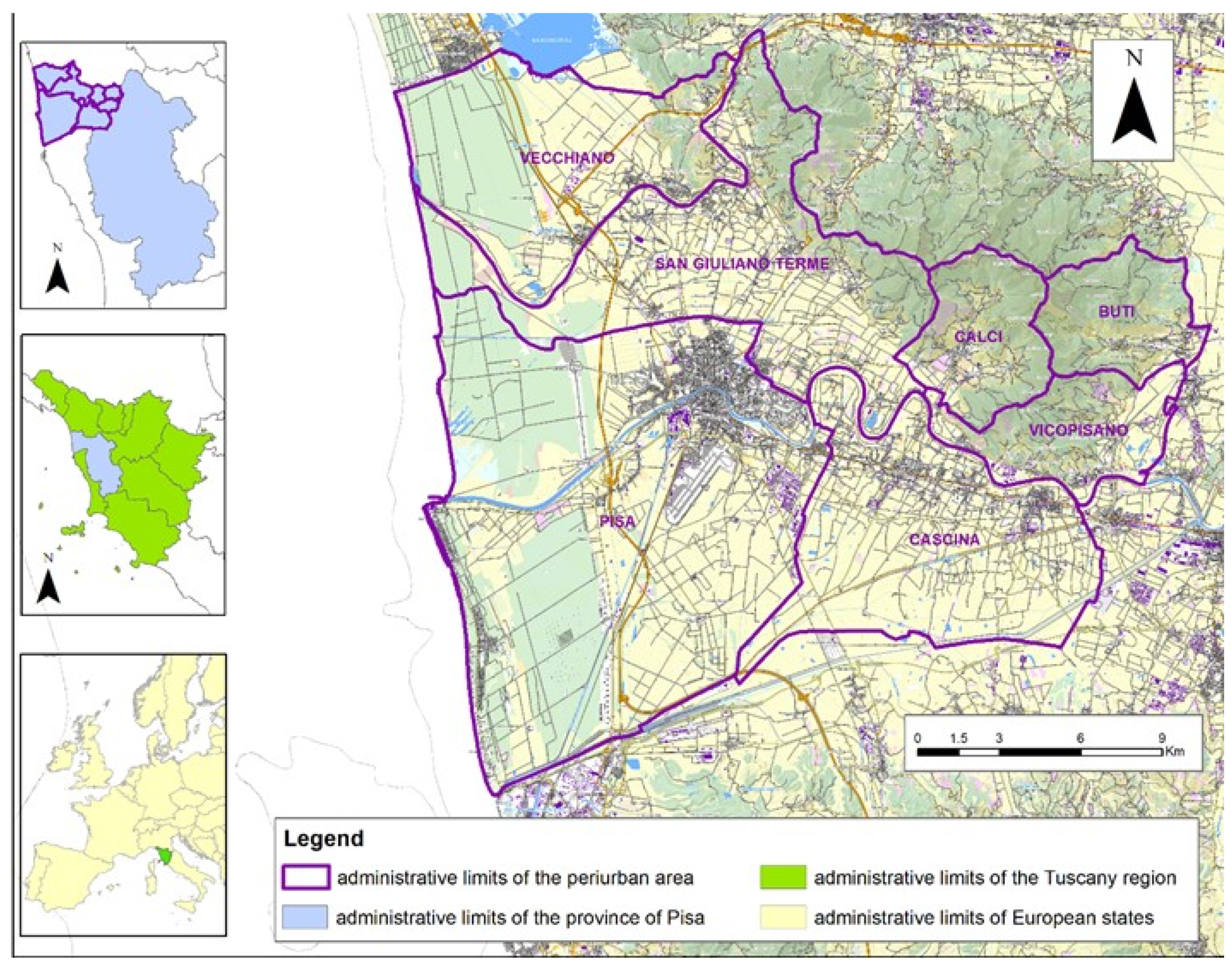
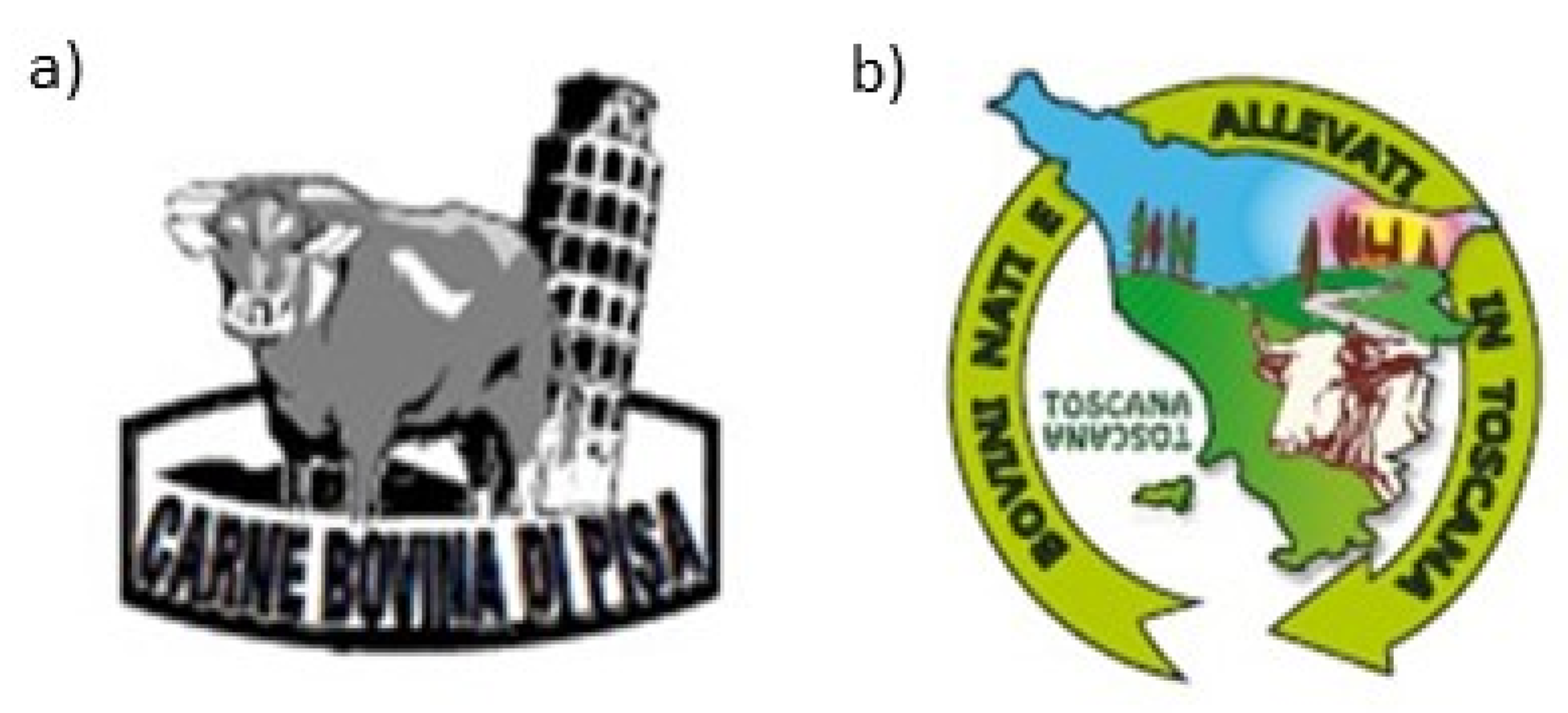
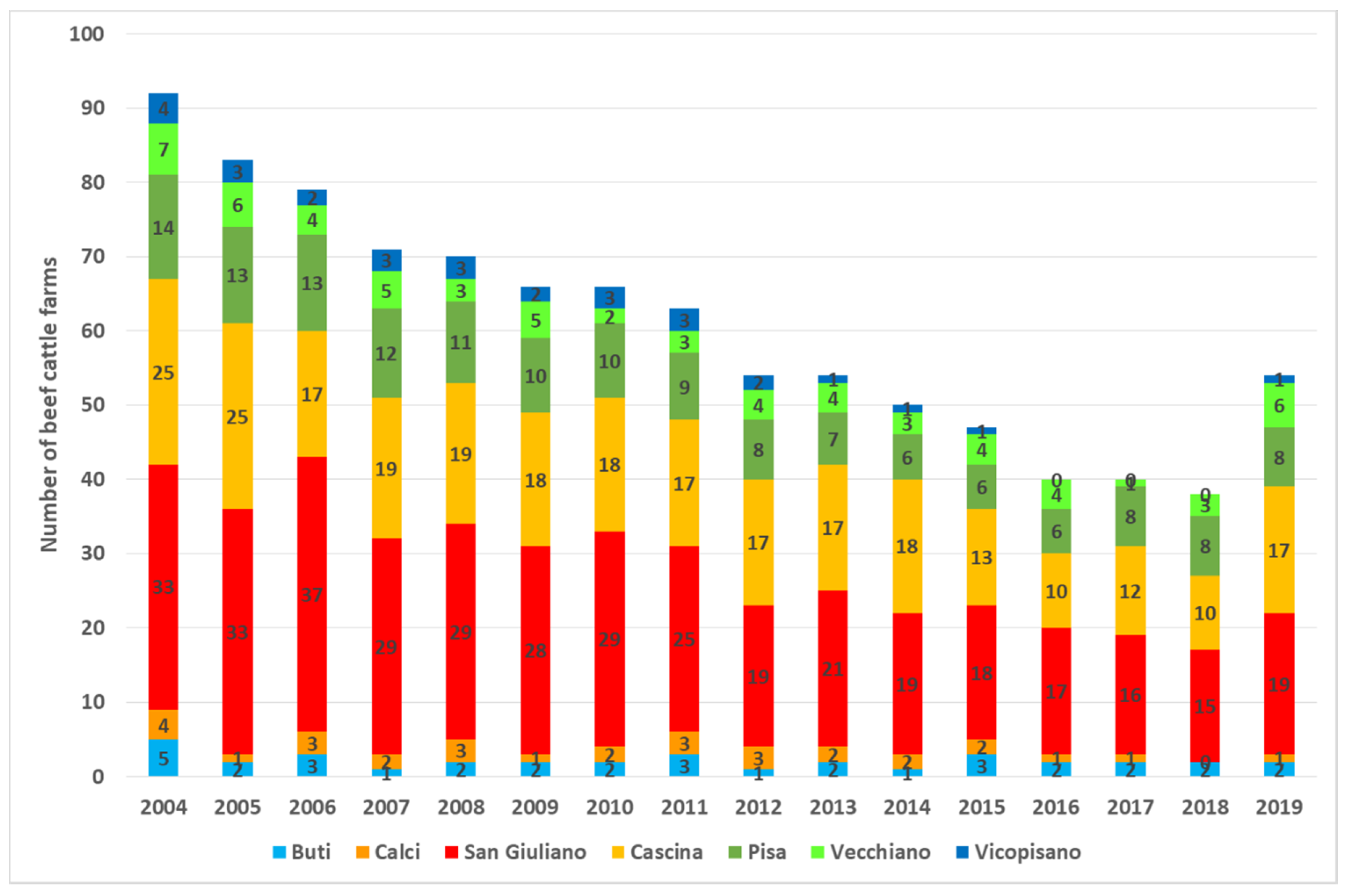
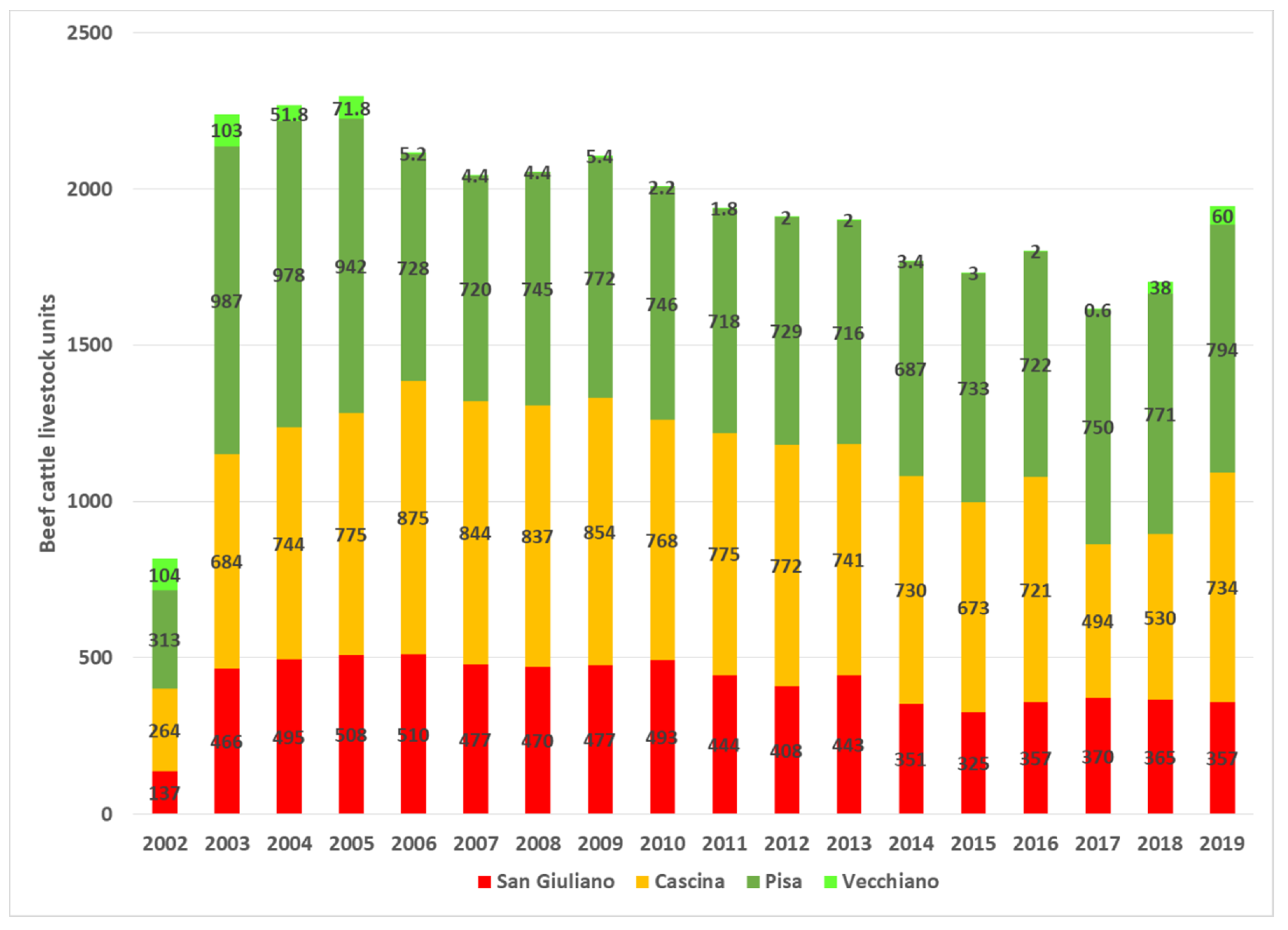



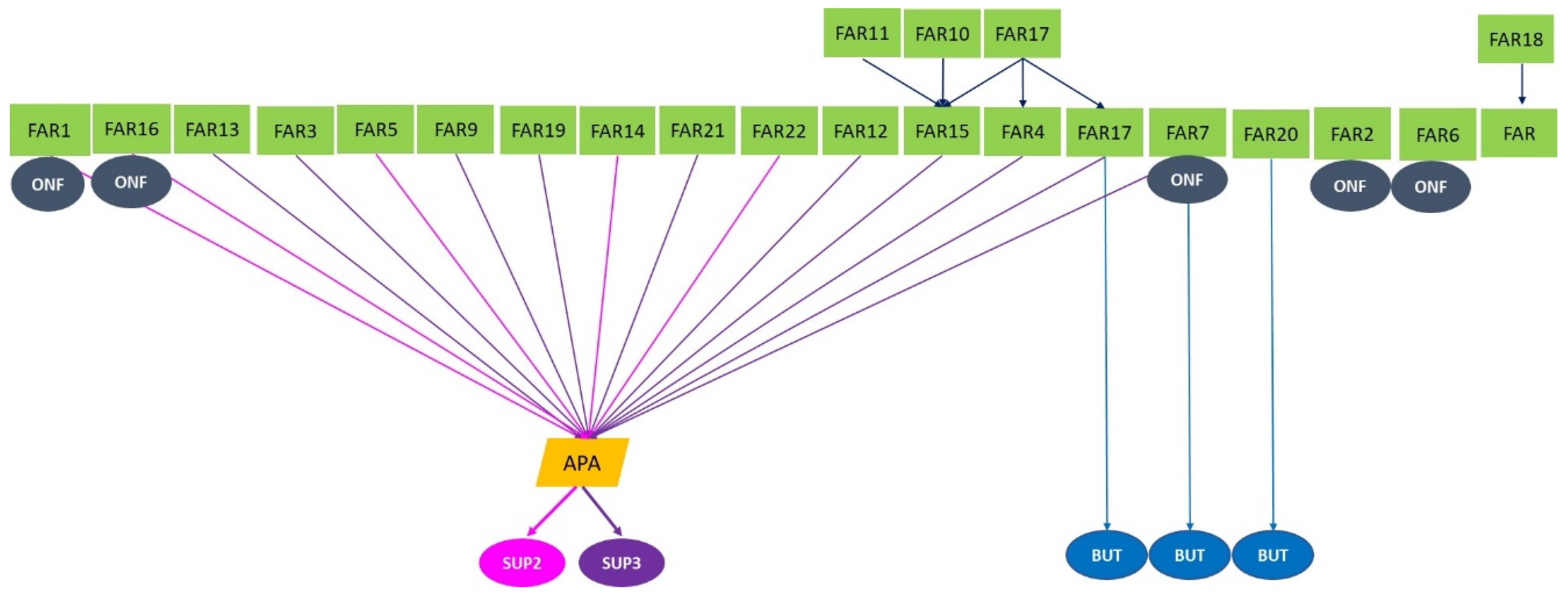
| Actors (n°) | Description | Main Role in the Project | Code |
|---|---|---|---|
| Farmers (2) | Private actor (1) and Public actor (1: University) | Production (2) and direct sale (1) | FAR1; FAR2; |
| Supermarkets (2) | Private actor | Processing (1) and sale (2) | SUP2; SUP3 |
| Regional livestock association (1) | Private–public actor | Initiative and coordination | APA |
| Localization | Production | Breed | LSU | % in SFSC | % to the Supermarket | % to Butchery | % to Farmers | |
|---|---|---|---|---|---|---|---|---|
| FAR1 | PU | CC | MP | 50 | 70 | 30 | 0 | 0 |
| FAR2 | PU | CC | MP | 50 | 0 | 100 | 0 | 0 |
| FAR3 | PU | CC | LI | 20 | 0 | 100 | 0 | 0 |
| FAR4 | PU | CC | LI | 60 | 0 | 25 | n/a. | n/a. |
| FAR5 | PU | CC | MP | 30 | 0 | 100 | 0 | 0 |
| FAR6 | PU | CC | LI | 30 | 0 | 100 | 0 | 0 |
| FAR7 | PU | CC | LI | 20 | 80 | 20 | 0 | 0 |
| FAR8 | PU | BORN | LI | 50 | 0 | 0 | 0 | 100 |
| FAR9 | PU | BORN | MP | 30 | 0 | 0 | 0 | 100 |
| FAR10 | PU | BORN | LI | 40 | 0 | 5 | 0 | 95 |
| FAR11 | PU | BORN | LI | 40 | 0 | 5 | 0 | 95 |
| FAR12 | PU | CC | LI | 15 | 0 | 100 | 0 | 0 |
| FAR13 | RU | CC | LI | 40 | 0 | 100 | 0 | 0 |
| FAR14 | RU | CC | LI | 20 | 100 | 0 | 0 | 0 |
| FAR15 | RU | FAT | LI | 180 | 0 | 70 | 30 | 0 |
| FAR16 | RU | CC | LI | 30 | 80 | 20 | 0 | 0 |
| FAR17 | RU | FAT | LI | 20 | 0 | 90 | 10 | 0 |
| FAR18 | RU | CC | LI | 7 | 100 | 0 | 0 | 0 |
| FAR19 | RU | FAT | LI | 200 | 0 | 100 | 0 | 0 |
| FAR20 | RU | FAT | LI | 10 | 0 | 0 | 100 | 0 |
| FAR21 | RU | CC | LI | 6 | 0 | 100 | 0 | 0 |
| FAR22 | RU | CC | MP | 100 | 0 | 100 | 0 | 0 |
| The Systems: the “Resilience of What” | Challenges: the “Resilience to What” | Direct or Indirect Action of the Project | Impact of the Project in Line with the Resilience |
|---|---|---|---|
| On the peri-urban livestock farming system | Urban pressure | In 2013, the project was especially implemented by farms localized in the peri-urban area, so it seemed to be a source of resilience adapted to the peri-urban farmers. | In 2018 it was observed: - Integration of peri-urban and rural livestock farming systems. - Livestock farmers have a label to do direct sale to consumers and/or butcheries and restaurants. - Livestock farms increased in the peri-urban area. |
| Decreasing in the number of livestock farms. | The purpose of the project was to sustain the local breed and the farms that adopted these animals in the farms. | - Livestock farms increased in the peri-urban area. - The LSU number of Mucca Pisana is stable. | |
| Product specialization: tendency of farms to specialize in crops or in livestock. | The product specification states the need for farms to adopt a crop–livestock integration. | - No negative constraints perceived by farmers. | |
| No local food supply chain present: - The meat price prior to the project was very low. - The small butcheries were closing; thus, there was less ability in processing the autochthonous breed. | - Marketing and coordinating action operated by APA to have a fair price for both farmers and supermarkets as well as a regular provision. - Inclusion and supporting of commercial actors that have the know-how to process the local breed, especially the supermarket. | Development of a specific food supply chain (transformative). | |
| On the local food supply chain | Lack of consumers’ trust in the cattle production due to food safety crisis. | - Creation of a specific local label that reassures consumers and the commercial actors, especially supermarkets; they have trust in the technical assistance of APA. - Promotion operated by public institutions especially at the beginning of the project. | - Increasing demand of consumers. - Application of the CBP project experimentation to a wider regional context (transformative). |
| No market for certain productions, because: - Not enough or instable production. - Local commercial actors do not know how to involve local farmers. | Action of marketing and coordination of APA. | - Inclusion of other livestock farms in the project. - The production of Limousine has increased and that of Mucca Pisana is stable. - Diversification of the offer among the two supermarkets involved |
© 2020 by the authors. Licensee MDPI, Basel, Switzerland. This article is an open access article distributed under the terms and conditions of the Creative Commons Attribution (CC BY) license (http://creativecommons.org/licenses/by/4.0/).
Share and Cite
Filippini, R.; Gennai-Schott, S.; Sabbatini, T.; Lardon, S.; Marraccini, E. Quality Labels as Drivers of Peri-Urban Livestock Systems Resilience. Land 2020, 9, 211. https://doi.org/10.3390/land9070211
Filippini R, Gennai-Schott S, Sabbatini T, Lardon S, Marraccini E. Quality Labels as Drivers of Peri-Urban Livestock Systems Resilience. Land. 2020; 9(7):211. https://doi.org/10.3390/land9070211
Chicago/Turabian StyleFilippini, Rosalia, Sabine Gennai-Schott, Tiziana Sabbatini, Sylvie Lardon, and Elisa Marraccini. 2020. "Quality Labels as Drivers of Peri-Urban Livestock Systems Resilience" Land 9, no. 7: 211. https://doi.org/10.3390/land9070211
APA StyleFilippini, R., Gennai-Schott, S., Sabbatini, T., Lardon, S., & Marraccini, E. (2020). Quality Labels as Drivers of Peri-Urban Livestock Systems Resilience. Land, 9(7), 211. https://doi.org/10.3390/land9070211






